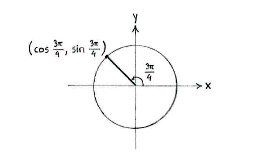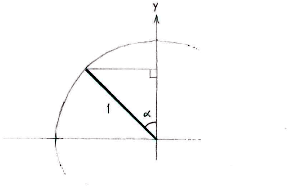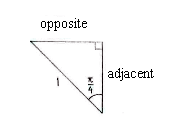Lösung 4.2:3e
Aus Online Mathematik Brückenkurs 1
K (hat „Solution 4.2:3e“ nach „Lösung 4.2:3e“ verschoben: Robot: moved page) |
|||
| Zeile 1: | Zeile 1: | ||
| - | + | Die Gerade mit dem Winkel <math>3\pi/4</math> zur positiven ''x''-Achse wird den Einheitskreis im zweiten Quadrant schneiden. | |
[[Image:4_2_3_e1.gif|center]] | [[Image:4_2_3_e1.gif|center]] | ||
| - | + | Nachdem die 'y''-Koordinate vom Schnittpunkt positiv ist, ist auch <math>\sin (3\pi/4)</math> positiv. | |
| - | + | Wir betrachten das Dreieck im zweiten Quadrant, dass die Gerade mit den Winkel <math>\sin (3\pi/4)</math> zur ''x''-Achse als Hypotenuse hat, und wo die Katheten parallel mit den Koordinatenachsen sind. | |
[[Image:4_2_3_e_2.gif|center]] | [[Image:4_2_3_e_2.gif|center]] | ||
| - | In | + | In diesen Dreieck sehen wir dass der Winkel <math>\alpha</math> zwischen der Hypotenuse und der ''y''-Achse, der teil des Winkels <math>3\pi/4</math> der in den zweiten Quadrant liegt. Also ist <math>\alpha = 3\pi/4 - \pi/2 = \pi/4\,</math>. Wir können die Seiten des Dreiecks mit Trigonometrie berechnen. |
{| width="100%" | {| width="100%" | ||
| Zeile 16: | Zeile 16: | ||
|} | |} | ||
| - | + | Also hat die Schnittstelle zwischen der geraden und den Einheitskreis die Koordinaten | |
| - | <math>(-1/\!\sqrt{2}, 1/\!\sqrt{2})</math> | + | <math>(-1/\!\sqrt{2}, 1/\!\sqrt{2})</math> und also ist <math>\sin (3\pi/4) = 1/\!\sqrt{2}\,</math>. |
Version vom 12:55, 4. Apr. 2009
Die Gerade mit dem Winkel \displaystyle 3\pi/4 zur positiven x-Achse wird den Einheitskreis im zweiten Quadrant schneiden.
Nachdem die 'y-Koordinate vom Schnittpunkt positiv ist, ist auch \displaystyle \sin (3\pi/4) positiv.
Wir betrachten das Dreieck im zweiten Quadrant, dass die Gerade mit den Winkel \displaystyle \sin (3\pi/4) zur x-Achse als Hypotenuse hat, und wo die Katheten parallel mit den Koordinatenachsen sind.
In diesen Dreieck sehen wir dass der Winkel \displaystyle \alpha zwischen der Hypotenuse und der y-Achse, der teil des Winkels \displaystyle 3\pi/4 der in den zweiten Quadrant liegt. Also ist \displaystyle \alpha = 3\pi/4 - \pi/2 = \pi/4\,. Wir können die Seiten des Dreiecks mit Trigonometrie berechnen.
| \displaystyle \begin{align}\text{opposite} &= 1\cdot\sin\frac{\pi}{4} = \frac{1}{\sqrt{2}}\\[5pt] \text{adjacent} &= 1\cdot\cos\frac{\pi}{4} = \frac{1}{\sqrt{2}}\end{align} |
Also hat die Schnittstelle zwischen der geraden und den Einheitskreis die Koordinaten \displaystyle (-1/\!\sqrt{2}, 1/\!\sqrt{2}) und also ist \displaystyle \sin (3\pi/4) = 1/\!\sqrt{2}\,.



